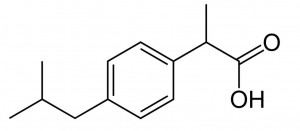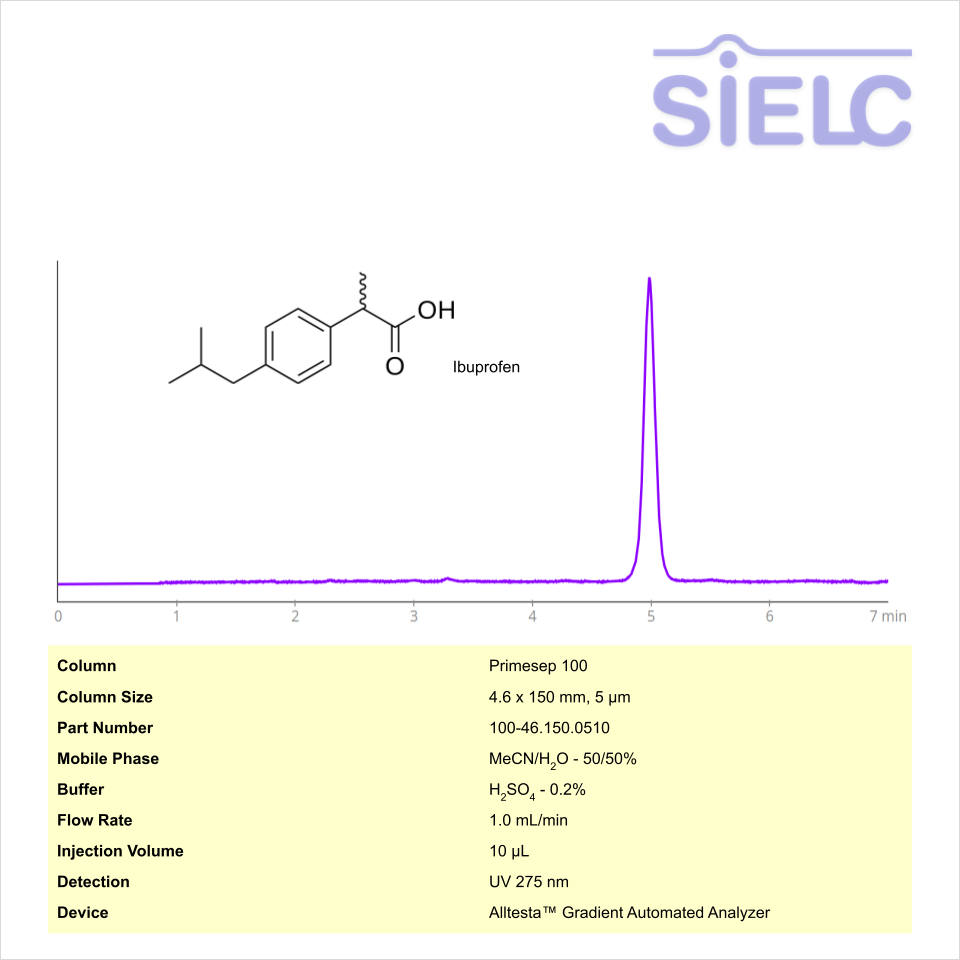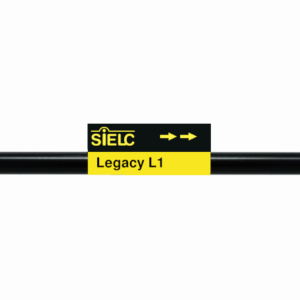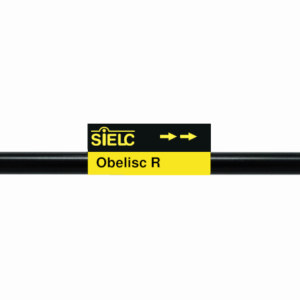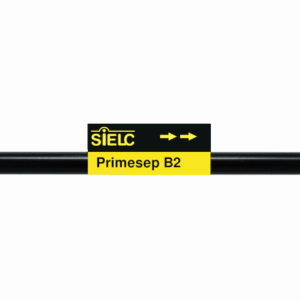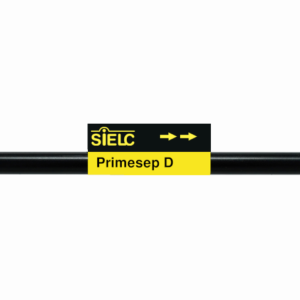| CAS Number | 15687-27-1 |
|---|---|
| Molecular Formula | C13H18O2 |
| Molecular Weight | 206.285 |
| InChI Key | HEFNNWSXXWATRW-UHFFFAOYSA-N |
| LogP | 3.5 |
| Synonyms |
|
Applications:
HPLC Method for Analysis of Ibuprofen on Primesep 100 Column on Alltesta™
November 25, 2025
HPLC Method for Ibuprofen on Primesep 100 by SIELC Technologies
High Performance Liquid Chromatography (HPLC) Method for Analysis of Ibuprofen
Ibuprofen is a nonsteroidal anti-inflammatory drug (NSAID) with the chemical formula C13H18O2. It is used primarily to relieve pain, fever, and inflammation. There is numerous adverse effects to taking ibuprofen, including but not limited to nausea, heightened risk of hypertension, kidney impairment, and bronchospasm.
Ibuprofen can be retained and analyzed using the Primesep 100 stationary phase column. The analysis utilizes an isocratic method with a simple mobile phase consisting of water and acetonitrile (MeCN) with phosphoric acid as a buffer. Detection is performed using UV.
| Column | Primesep 100, 4.6 x 150 mm, 5 µm, 100 A, dual ended |
| Mobile Phase | MeCN – 50% |
| Buffer | Sulfuric Acid |
| Flow Rate | 1.0 mL/min |
| Detection | UV 275 nm |
| Class of Compounds | Drug |
| Analyzing Compounds | Ibuprofen |
Application Column
Primesep 100
Column Diameter: 4.6 mm
Column Length: 150 mm
Particle Size: 5 µm
Pore Size: 100 A
Column options: dual ended

USP Methods for the Analysis of Ibuprofen using a Legacy L1 Column
June 21, 2012
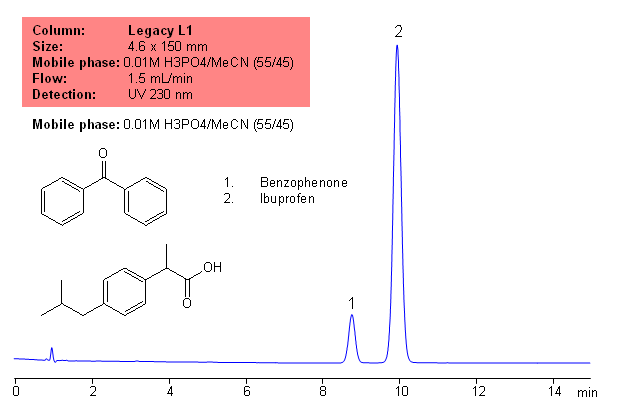
Application Notes: Ibuprofen is the most commonly used analgesic. It is a vasoconstrictor and fever reducer. According to the USP methods, ibuprofen contains no less than 97% and no more than 103% ibuprofen based on a dried basis. The USP HPLC method for the separation of procainamide was developed on Legacy L1 column according to the US Pharmacopeia methodology. L1 classification is assigned to reversed-phase HPLC column containing Ci18 ligand. Support for the material is spherical silica gel with particles size 3-10 um and pore size of 100-120A. Resolution between critical pairs corresponds to rules and specifications of USP.
Application Columns: Legacy L1 C18 HPLC column
Application compounds: Ibuprofen and benzophenone
Mobile phase: .01M H3PO4/MeCN (55/45)
Detection technique: UV
Reference: USP35: NF30
| Column | Legacy L1, 4.6×150 mm, 5 µm, 100A |
| Mobile Phase | MeOH/H2O – 45/55% |
| Buffer | H3PO4 |
| Flow Rate | 1.5 ml/min |
| Detection | UV, 230 nm |
| Class of Compounds |
Drug, Nonsteroidal anti-inflammatory drug, Hydrophobic, Ionizable, Neutral |
| Analyzing Compounds | Ibuprofen, benzophenone |
Application Column
Legacy L1
SIELC's family of Legacy columns is based on the United States Pharmacopeia's (USP) published chromatographic methods and procedures. Numerous brands have columns used in USP reference standards and methods. USP has created various designations to group together columns with similar types of packing and properties in the solid phase. SIELC's Legacy columns adhere to these strict requirements and properties, allowing you to easily replace older columns that are no longer available without needing to significantly modify your method or SOPs.
Select optionsIbuprofen

HPLC Separation of Acidic Drugs and Counter-Ions on Obelisc R Column
October 4, 2010
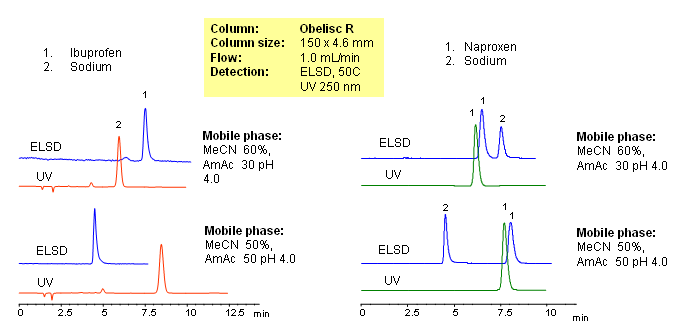
Mixed-mode columns allow to quantitate drugs and their counter-ions in one run. Hydrophobic acidic drug and hydrophilic inorganic counter-ions are separated and quantified on an Obelisc R HPLC trimodal column. This column can be used to quantify hydrophilic basic and hydrophilic acidic drugs, hydrophobic basic and hydrophobic acidic drugs, and corresponding organic and inorganic counter-ions. Various detection techniques can be applied to obtain reliable and robust method. Mixed-mode chromatography allows to retain ionizable compounds without ion-pairing reagent. This HPLC method can be adopted as universal and robust approach for analysis basic and acidic drugs and their counter-ions. Method is compatible with various detection techniques – ELSD, UV, CAD, and LC/MS.
Application Column
Obelisc R
SIELC has developed the Obelisc™ columns, which are mixed-mode and utilize Liquid Separation Cell technology (LiSC™). These cost-effective columns are the first of their kind to be commercially available and can replace multiple HPLC columns, including reversed-phase (RP), AQ-type reversed-phase, polar-embedded group RP columns, normal-phase, cation-exchange, anion-exchange, ion-exclusion, and HILIC (Hydrophilic Interaction Liquid Chromatography) columns. By controlling just three orthogonal method parameters - buffer concentration, buffer pH, and organic modifier concentration - users can adjust the column properties with pinpoint precision to separate complex mixtures.
Select optionsIbuprofen Sodium
Naproxen Sodium
UV Detection

HPLC Separation of Prednisolone, Atrolactic Acid, and Ibuprofen on Mixed-Mode Column
October 4, 2010
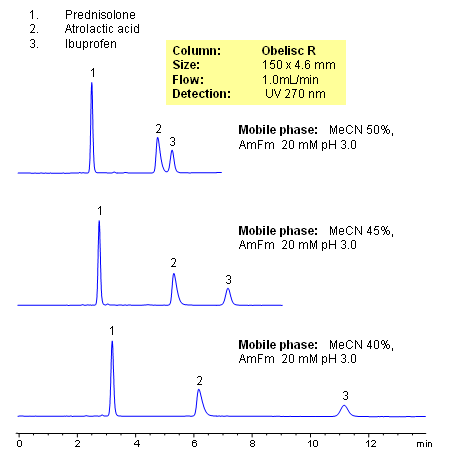
Prednisolone, atrolactic acid, and ibuprofen were separated in one HPLC run on an Obelisc R HPLC column. Obelisc R columns have C12 carbon chain and basic and acidic groups on the surface of silica gel. Compounds are separated by combination of reversed-phase, cation-exchange, and anion-exchange mechanisms. Obelisc R column can be used for retention and separation of acidic and basic hydrophilic compounds, acidic and basic hydrophobic compounds, and neutral compounds. Elution is monitored by common detection techniques like UV, ELSD, CAD and LC/MS.
Application Column
Obelisc R
SIELC has developed the Obelisc™ columns, which are mixed-mode and utilize Liquid Separation Cell technology (LiSC™). These cost-effective columns are the first of their kind to be commercially available and can replace multiple HPLC columns, including reversed-phase (RP), AQ-type reversed-phase, polar-embedded group RP columns, normal-phase, cation-exchange, anion-exchange, ion-exclusion, and HILIC (Hydrophilic Interaction Liquid Chromatography) columns. By controlling just three orthogonal method parameters - buffer concentration, buffer pH, and organic modifier concentration - users can adjust the column properties with pinpoint precision to separate complex mixtures.
Select optionsPrednisolone

HPLC Analysis of Motrin Cough & Cold Composition
July 16, 2009
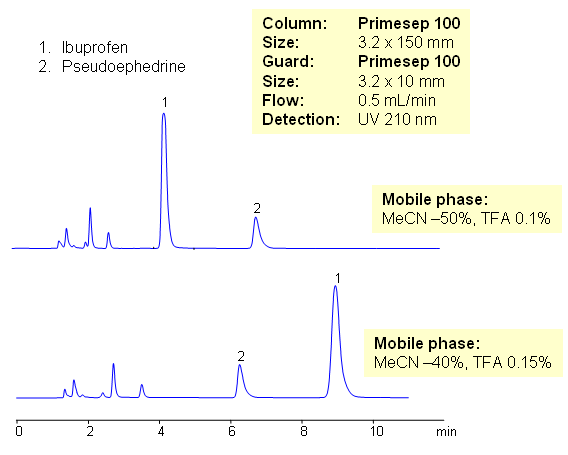
Motrin is cough and cold composition manufactured by McNeil PPC. It contains ibuprofen as non-steroidal anti-inflammatory drug (N-SAID) and pseudoephedrine as decongestant. Ibuprofen is hydrophobic acidic molecule and pseudoephedrine hydrophilic molecule. Pseudoephedrine does not retained well in reversed phase chromatography and requires the use of ion-pairing reagent. In the absence of ion-pairing reagent pseudoephedrine comes close to the void of the column even at low concentrations of acetonitrile, while ibuprofen shows strong retention by reversed-phase mechanism. Different properties of these two molecules require gradient elution and consequent equilibration of the column. In contrast when mixed-mode HPLC column, like Primesep 100, is used, the method can be isocratic, very short with no equilibration of the column. Ibuprofen is retained by strong reversed-phase mechanism and pseudoephedrine is retained by weak reversed-phase and strong cation-exchange mechanisms on Primesep 100 column. Retention time of hydrophobic molecule is controlled by amount of acetonitrile, and retention of hydrophilic basic molecule is controlled by the amount of buffer and buffer pH. Method can be UV, ELSD and LC/MS compatible with various additives to the mobile phase (TFA, ammonium formate or acetate, sulphate or phosphate buffers at various pH). This mixed-mode column can be used for analysis of other OTC drugs including mixtures of basic, acidic and hydrophobic compounds.
Application Column
Primesep 100
The Primesep family of mixed-mode columns offers a wide variety of stationary phases, boasting unprecedented selectivity in the separation of a broad array of chemical compounds across multiple applications. Corresponding Primesep guard columns, available with all stationary phases, do not require holders. SIELC provides a method development service available to all customers. Inquire about our specially-tailored custom LC-phases for specific separations.
Select optionsMotrin
Pseudoephedrine (PSE)
UV Detection

HPLC Method for Determination of Lysine in Ibuprofen Lysine Composition
July 16, 2009
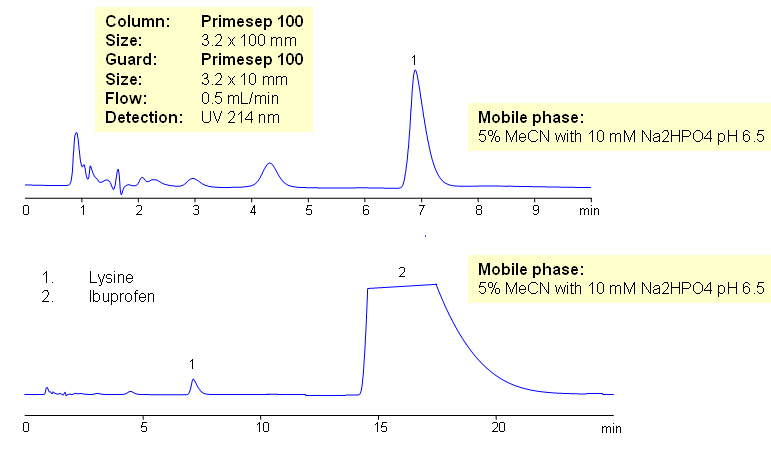
Ibuprofen lysine is ibuprofen based medication which is uses lysine as counter-ion of the ibuprofen. The use of lysine makes the drug more soluble in water. Lysine is very hydrophilic compound with low UV activity, while ibuprofen is hydrophobic compound with good UV activity. These properties are making straight analysis of Ibuprofen Lysine (ibuprofen lysinate) a challenging task. Ion-pairing reagent required for retention of lysine in reversed-phase chromatography. Both compounds can be quantitated in one run without use of IP reagent. Because of the huge difference in UV activity of ibuprofen and lysine, a separate method for quantitation of lysine in ibuprofen lysinate might be required. Separation involving switching valve and guard column allows to trap ibuprofen on the guard and wash it away during analysis of lysine. This HPLC method allows to quantitate lysine separately from ibuprofen. Detailed set up of switching valve/guard system is described in our newsletter. Method can be adapted to quantitation of single compound in complex mixtures.
Lysine

HPLC Separation of Drugs in Advil Allergy and Sinus
August 22, 2008
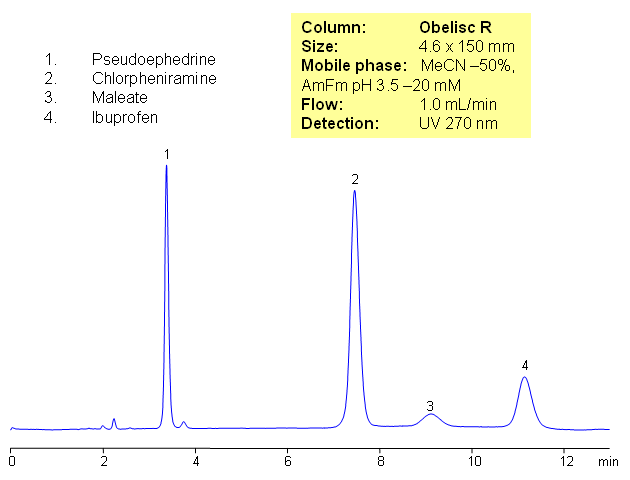
Ibuprofen is in a group of drugs called non-steroidal anti-inflammatory drugs (NSAIDs). Ibuprofen works by reducing hormones that cause inflammation and pain in the body.
Pseudoephedrine is a decongestant that shrinks blood vessels in the nasal passages. Dilated blood vessels can cause nasal congestion (stuffy nose).
The combination of chlorpheniramine, ibuprofen, and pseudoephedrine is used to treat sneezing, itching, watery eyes, runny nose, stuffy nose, sinus congestion, cough, and pain or fever caused by the common cold or flu in common over-the-counter medication (Advil, NyQuil, Tylenol, etc.)
Active ingredients of Advil Allergy and Sinus composition are separated by combination of reverse phase, cation-exchange and anion exchange mechanisms. Obelisc R mixed-mode column is used to separate pseudoephedrine (polar basic compound), chlorpheniramine (hydrophobic basic compound), ibuprofen (hydrophobic acidic compound) and maleic acid (counter-ion, hydrophilic acid compound). Method can be used for QC in production, impurity profiling and research and development. All compounds are well separated with high efficiency and good peak shape. Method uses ammonium formate buffer but other buffers can be used as well (ammonium acetate, sodium and ammonium phosphate) with corresponding detection technique – ELSD, LC/MS, and UV. Chlorpheniramine is an antihistamine that reduces the natural chemical histamine in the body. Histamine can produce symptoms of sneezing, itching, watery eyes, and runny nose.
Application Column
Obelisc R
SIELC has developed the Obelisc™ columns, which are mixed-mode and utilize Liquid Separation Cell technology (LiSC™). These cost-effective columns are the first of their kind to be commercially available and can replace multiple HPLC columns, including reversed-phase (RP), AQ-type reversed-phase, polar-embedded group RP columns, normal-phase, cation-exchange, anion-exchange, ion-exclusion, and HILIC (Hydrophilic Interaction Liquid Chromatography) columns. By controlling just three orthogonal method parameters - buffer concentration, buffer pH, and organic modifier concentration - users can adjust the column properties with pinpoint precision to separate complex mixtures.
Select optionsIbuprofen
Maleate
Pseudoephedrine (PSE)

HPLC Analysis of Gemfibrozil and Ibuprofen Using Mixed-Mode Chromatography
May 6, 2005
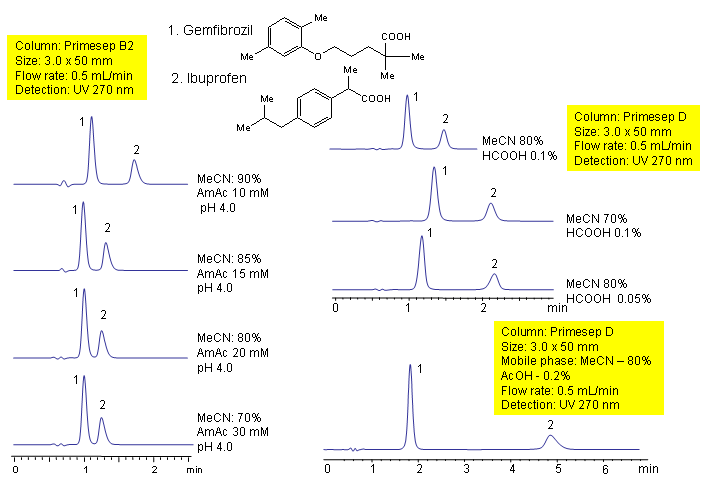
Gemfibrozil is used to lower cholesterol and triglyceride levels in the blood and Ibuprofen is a common over-the-counter painkiller. Fast separations of these two compounds are obtained on short 50 mm columns. Both Primesep B2 and Primesep D separate by a combination of anion exchange and reversed phase. Retention times on Primesep B2 can be adjusted by changing the percentage of acetonitrile. On Primesep D retention times can be changed by adjusting the percentage of acetonitrile and acetic acid in the mobile phase. The HPLC separations use a mobile phase of water, acetonitrile (MeCN, ACN), ammonium formate and acetic acid (HOAc) with UV detection at 270 nm.
Application Column
Primesep B2
The Primesep family of mixed-mode columns offers a wide variety of stationary phases, boasting unprecedented selectivity in the separation of a broad array of chemical compounds across multiple applications. Corresponding Primesep guard columns, available with all stationary phases, do not require holders. SIELC provides a method development service available to all customers. Inquire about our specially-tailored custom LC-phases for specific separations.
Select optionsPrimesep D
The Primesep family of mixed-mode columns offers a wide variety of stationary phases, boasting unprecedented selectivity in the separation of a broad array of chemical compounds across multiple applications. Corresponding Primesep guard columns, available with all stationary phases, do not require holders. SIELC provides a method development service available to all customers. Inquire about our specially-tailored custom LC-phases for specific separations.
Select optionsIbuprofen

